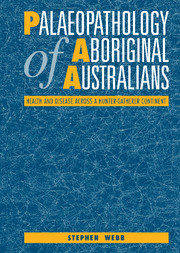Book contents
- Frontmatter
- Contents
- List of illustrations
- List of tables
- Acknowledgements
- 1 Introduction
- 2 Australian palaeopathology, survey methods, samples and ethnohistoric sources
- 3 Upper Pleistocene pathology of Sunda and Sahul: some possibilities
- 4 Pathology in late Pleistocene and early Holocene Australian hominids
- 5 Stress
- 6 Infectious disease
- 7 Osteoarthritis
- 8 Trauma
- 9 Neoplastic disease
- 10 Congenital malformations
- 11 Motupore: the palaeopathology of a prehistoric New Guinea island community
- 12 The old and the new: Australia's changing patterns of health
- References
- Index
10 - Congenital malformations
Published online by Cambridge University Press: 21 May 2010
- Frontmatter
- Contents
- List of illustrations
- List of tables
- Acknowledgements
- 1 Introduction
- 2 Australian palaeopathology, survey methods, samples and ethnohistoric sources
- 3 Upper Pleistocene pathology of Sunda and Sahul: some possibilities
- 4 Pathology in late Pleistocene and early Holocene Australian hominids
- 5 Stress
- 6 Infectious disease
- 7 Osteoarthritis
- 8 Trauma
- 9 Neoplastic disease
- 10 Congenital malformations
- 11 Motupore: the palaeopathology of a prehistoric New Guinea island community
- 12 The old and the new: Australia's changing patterns of health
- References
- Index
Summary
General introduction
About 2 per cent of children are born with some kind of congenital malformation or abnormality (Oldfield 1959). How far back this frequency goes or whether it has changed over time is impossible to tell. Congenital defects must have occurred among us from our earliest beginnings but we can only assume that many of these were terminated, either by natural spontaneous abortion or social sanction through abandonment or infanticide. If obvious skeletal defects have been with us for some time there is little solid evidence to support the idea. It is not until the late Pleistocene that firm evidence for such malformations becomes available (Ferembach 1963).
Spina bifida
The frequency of neural tube defects (NTDs), such as spina bifida, anencephaly and encephalocoeles, varies from 0.5–1.0 per cent (Jorde et al 1983). Among modern societies spina bifida varies from around 0.1–0.25 per cent and rates of survival vary between 50–80 per cent depending on the severity of the defect (Schwidde 1952; Manchester 1983). In developed countries survival rates are much better than they used to be because of the intervention of modern medical care and improved surgical techniques. One can only assume that in the past, particularly the distant past, rates of survival were much lower. Certainly, those born with severe spina bifida with a myelomeningocoele (rachischisis) would quickly die, as they would today without medical care.
- Type
- Chapter
- Information
- Palaeopathology of Aboriginal AustraliansHealth and Disease across a Hunter-Gatherer Continent, pp. 235 - 255Publisher: Cambridge University PressPrint publication year: 1995



